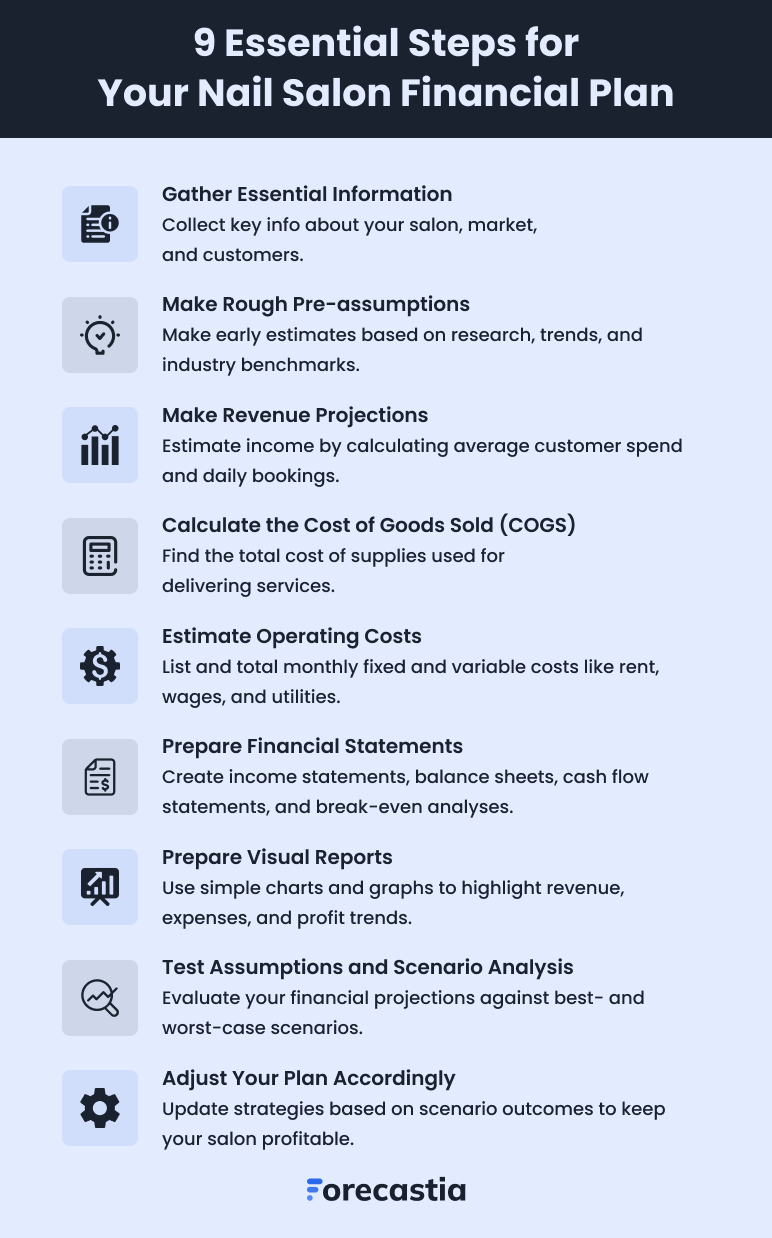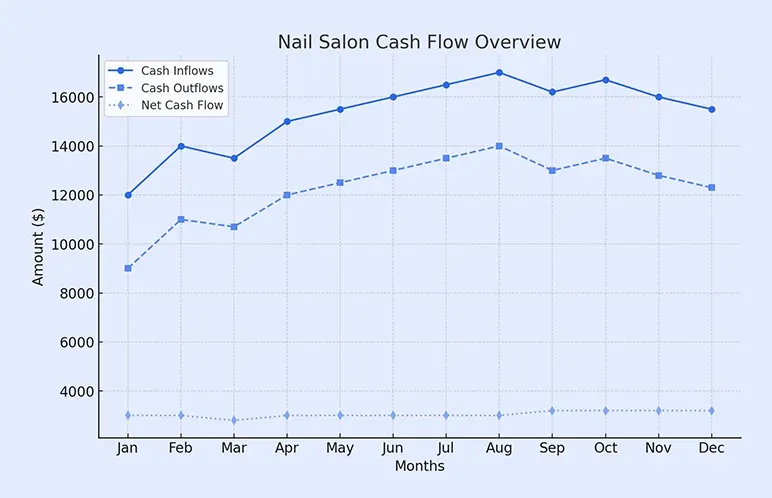These days, people are getting their nails done more often than they get groceries—whether it’s for self-care or special events. But while demand is high, so are the costs of running a nail salon.
Between product expenses, rent, staffing, and slow seasons, it’s easy to lose track of your business’s financial health. And if you’re not careful, profits can disappear fast.
That’s why you need a strong financial plan to keep your salon running smoothly and growing.
Not sure how to create one?
No problem—this guide breaks it down step by step so you can focus on giving clients the perfect set!
How do you build nail salon financial projections?
Creating realistic financial projections for your nail salon involves thorough analysis and meticulous planning to comprehend its financial health and growth potential.
Here’s a step-by-step guide to help you build accurate and actionable projections while ensuring you factor in every detail:

1. Gather essential information
First, collect all the relevant key data that lays the groundwork for accurate financial projections.
This would include nail salon details like:
- Current operations
- Target demographics
- Historical financial performance
- And industry benchmarks.
Look at your nail salon’s sales—when do you book the most appointments? Are weekends busier? Do holidays bring in more clients? Spotting these trends helps you plan for cash flow and growth.
For new nail salons, analyze the latest market trends, industry benchmarks, and local competitors to make educated estimates.
Get to know your nail salon clients inside out.
- Who are they?
- What services do they love?
- How often do they visit?
Then, keep an eye on your inventory—track product use, restock rates, and supplier costs to keep expenses in check.
Most importantly, don’t forget to evaluate the past performance data of your nail salon to understand what drives your business.
Consider analyzing previous revenues, costs, and profits to detect trends and highlight the areas for improvement.
See how your promos, service add-ons, or seasonal trends affected your sales and costs. Did a holiday discount bring in more bookings? Did a new nail design boost revenue? Tracking these shifts helps you plan smarter.
That’s how you'll have everything you need to create accurate and actionable financial projections.
2. Make rough pre-assumptions
Now, make some preliminary assumptions for your nail salon’s financial projections based on gathered data. Such estimates will outline your business's revenues, expenses, and profitability levels.
Start by focusing on the basics: How much you’ll make in monthly sales, how much customers will spend on average, and what your operating costs might look like.
Use the understanding of past sales trends, industry benchmarks, and your own research.
Consider seasonal trends and new service offerings that might impact your numbers. Will the holiday rush bring more bookings? Will a new nail art trend drive up costs? Planning ahead keeps your finances on track.
Here are a few key metrics to consider while making your assumptions:
- Revenue growth: Predict a percentage increase in sales, such as a 5% annual growth based on an expanding customer base or marketing efforts.
- Cost increases: Plans for rising expenses, like higher product prices or wage adjustments—expect utilities to jump 10% in summer due to AC use.
- Seasonality: Account for holiday rushes that boost bookings and slow months like January when clients cut back after the holidays.
- Economic conditions: Account for inflation, rising wages, or other economic factors that may impact both costs and customer spending power.
Don’t aim for perfection—these are rough estimates to guide your planning that will evolve over time. So, revisit them periodically as actual data comes in.
3. Make revenue projections
Revenue projections are all about figuring out how much money your nail salon might make.
To get started, think about a few simple things: How many clients you can serve daily, how quickly appointments turn over, and the average spend per visit.
Breaking it down step-by-step makes it easier to see your earning potential.
If your nail salon handles 10 chairs, with each client spending $50 per visit and you book 5 appointments per chair daily, here’s the math:
10 chairs × 5 clients × $50 × 30 days
= $75,000/month
But don’t forget about holidays, weekends, and special events—they can bring in more clients and boost revenue. On the other hand, slow weekdays or off-season months might drive fewer bookings and lower income.
Additionally, account for other ways to make money. Upselling nail art, memberships, retail products, or hosting private events can add a big boost to your monthly revenue.
By including these extra streams, you’ll get a more accurate picture of what your nail salon can earn.
4. Calculate the Cost of Goods Sold (COGS)
Next, calculate your Cost of Goods Sold (COGS)—the direct costs of providing nail services. This includes polishes, acrylics, gels, nail tools, and other salon products used for each appointment.
Here's an easy way to do your COGS calculation:
List your supplies – Write down everything used for nail services, like polish, acrylics, gels, files, cotton pads, and cuticle oil.
Find the costs – Check invoices or supplier receipts to see how much each product costs.
Calculate per service – If a gel manicure costs $5 in materials and you do 300 a month, your COGS for that service is $1,500.
Total it up – Add up costs for all services to get your monthly COGS.
For example, if your salon spends $5,000 a month on supplies and generates $25,000 in revenue, your
Knowing your COGS will help you manage expenses, optimize resources, and boost profits.
5. Estimate operating costs
Next, describe the expected expenses incurred to operate your nail salon.
When calculating your nail salon’s operational costs:

Lastly, sum up the fixed and variable costs to come up with your total operating costs.
Example: If your nail salon’s rent is $5,000, utilities are $1,500, wages total $20,000, and marketing & other expenses add up to $3,500, your operating expenses would be:
$5,000 + $1,500 + $20,000 + $3,500
= $30,000/month
Overall, by calculating your operating costs, you can manage your budget and know whether your revenues can cover all the expenses to leave room for profit.
6. Prepare financial statements
After estimating your nail salon's revenue, COGS, and operating expenses, it’s time to draft clear financial statements. These documents are essential for illustrating your nail salon’s financial health and growth potential to prospective investors.
Here are the critical financial statements and reports that you should consider including in your plan:
- Income statement (profit and loss statement)
- Cash flow statement
- Balance sheet
- Break-even analysis
By adding these financial statements, you showcase your financial standing to potential investors so they can make well-informed decisions regarding investment.
We'll explore each of these financial components in greater detail in the upcoming sections, giving you the insights needed to create a strong financial plan.
7. Prepare visual reports
Numbers alone aren't enough. Present your nail salon’s financial data in a visually appealing and easily digestible format that readers can quickly understand and get valuable insights.
Using charts and graphs makes it easier to highlight your nail salon’s key aspects, including revenue trends, expenses, profit margins, and cash flow.
Don’t worry; it’s easy. Use simple bar charts, pie charts, and line graphs to make the data clear. Also, highlight patterns like seasonal sales changes or rising costs to help with planning.
This will not only help analyze financial data but also enable you to communicate key metrics effectively to your team as well as investors.
8. Test assumptions, consider scenario analysis
Finally, take a step back and test the numbers to ensure your projections are more accurate. Try to run different scenarios (best- and worst-case) to see how changes impact your financial outcomes.
For example, see how a 15% rise in supply costs affects your expenses or how fewer bookings in slow months impact revenue. If nail polish costs go up or weekday traffic drops, you’ll need to adjust pricing or promotions to stay profitable.
Considering these “what-if” situations helps you identify potential problems in business operations and come up with solutions in advance. It even increases transparency and lets investors better understand your nail salon’s future with different scenarios.
Overall, these test assumptions and sensitivity analyses will help you make strategic decisions and necessary adjustments to keep your nail salon running smoothly.
Key financial statements of a nail salon financial plan
A detailed nail salon financial plan typically includes important financial documents like the income statement, cash flow statement, balance sheet, and break-even analysis.
These reports clearly describe your nail salon's current monetary position and the overall financial strategy to achieve future goals.

Let's explore each statement in detail.
1. Income statement
The income statement is also known as the profit and loss statement. It gives you a solid understanding of your nail salon’s revenue, expenses, gross margin, and net profit for a specific time.
It helps you see whether your business is making enough money to cover its costs and turn a profit.
The gross profit is what you get after subtracting the COGS from the total revenue. This shows how efficiently your nail salon uses its resources.
Further, divide the gross profit by revenue and convert it into a percentage to determine the gross margin.
Next, subtract your operating costs (rent, salaries, utilities, and other expenses) from your total revenue to calculate EBITDA. Finally, subtract interest, taxes, depreciation, and amortization from the EBITDA to arrive at the net profit of your nail salon—the figure that investors care about the most.
Here’s an example of a mid-sized nail salon’s income statement to demonstrate these calculations:
| Category | Amount ($) |
|---|---|
| Total Revenue | $150,000 |
| - Manicures | $60,000 |
| - Pedicures | $50,000 |
| - Nail Art and Extensions | $25,000 |
| - Product Sales (Lotions, Nail Care Kits, etc.) | $15,000 |
| Total Expenses | $110,000 |
| - Fixed Costs | $60,000 |
| - Rent | $30,000 |
| - Salaries and Wages | $20,000 |
| - Insurance | $5,000 |
| - Licenses and Permits | $5,000 |
| - Variable Costs | $50,000 |
| - Supplies (Nail Polish, Files, Gloves, etc.) | $20,000 |
| - Marketing and Advertising | $10,000 |
| - Utilities (Electricity, Water, Internet) | $10,000 |
| - Laundry and Cleaning Services | $5,000 |
| - Payment Processing Fees | $5,000 |
| Gross Profit | $40,000 |
| Other Income (Loyalty Programs, Gift Cards) | $5,000 |
| Adjusted Net Profit (Before Tax) | $45,000 |
| Taxes (20% of Net Profit Before Tax) | ($9,000) |
| Net Profit (After Tax) | $36,000 |
| Retained Earnings | $10,000 |
| Owner’s Draw | $26,000 |
Bella’s Nail Studio made $150,000 in revenue, mostly from manicures, pedicures, and nail art.
After covering $110,000 in expenses, she earned $40,000 before taxes.
With a 20% tax deduction, her final take-home profit was $32,000.

In simple terms, the income statement tells you if your nail salon is making money and staying financially healthy over time.
2. Cash flow statement
A cash flow statement shows how money is coming in and going out of your nail salon over a certain period. It helps you figure out if you have enough cash to cover your daily expenses.
To create a nail salon income statement, include:
- Cash from sales – Total revenue from nail services, upsells, and product sales
- Costs – Expenses for nail supplies, polishes, gels, and tools
- Overhead expenses – Fixed and variable costs like rent, wages, utilities, and marketing
It highlights how much money your nail salon is making and spending during that period.

Bella’s Nail Studio sees higher revenue in the holiday season (November - December), with cash inflows reaching $16,500 per month.
However, slower months like January and February see lower earnings ($12,000 - $14,000).
That said, it’s a good illustration of how well your business is at generating cash. The precision of your projections in these aspects directly impacts the reliability of your cash flow.
So, be realistic with the assumptions you make in the cash flow statement. Use industry standards and consider market situations to ensure accuracy.
3. Balance sheet
A balance sheet gives a quick snapshot of your nail salon’s financial position for a specific timeframe. It shows what the nail salon owns, what it owes to others, and what’s left for you.
After all, it covers these key elements:
- Assets – Cash on hand, accounts receivable, salon equipment, and property.
- Liabilities – Short-term debts, supplier payments, and long-term loans.
- Equity – The remaining earnings after subtracting liabilities from assets.
Ideally, it’s presented as, Assets = Liabilities + Equity.
| Nail Salon Balance Sheet Summary | Amount ($) |
|---|---|
| Assets | |
| - Cash | $50,000 |
| - Equipment | $70,000 |
| - Furniture | $30,000 |
| - Inventory | $50,000 |
| Total Assets | $200,000 |
| Liabilities | |
| - Loans | $40,000 |
| - Accounts Payable | $20,000 |
| - Other Outstanding Expenses | $15,000 |
| Total Liabilities | $75,000 |
| Equity | |
| - Owner’s Investment | $80,000 |
| - Retained Earnings | $45,000 |
| Total Equity | $125,000 |
| Total Liabilities and Equity | $200,000 |
- Total Assets ($200,000):
Includes cash, equipment, furniture, and inventory.
- Total Liabilities ($75,000):
Loans, accounts payable, and outstanding expenses.
- Total Equity ($125,000):
The owner’s investment and retained earnings.

Investors really pay close attention to the balance sheet because it shows them your nail salon’s financial structure, return on investment (ROI), and overall stability.
It also provides an idea of the cash that is available to you, how the money is blocked, and what kind of solid business you are running.
4. Break-even analysis
We all know that profit is the all-time motive of all nail salon owners. The real question is: When does the money actually start coming in?
A break-even analysis fits the bill at this stage. It shows exactly how much you’ll need to generate in revenue for all the costs to be recovered—no profit and no loss; just breaking even.
Let's take an example to see how it works.
For a nail salon:
- Fixed costs: $12,000 (Rent: $6,000, Utilities: $2,000, Wages: $4,000)
- Variable costs: $18,000 (Nail supplies, tools, product restocks)
- Revenue: $50,000
Contribution Margin:
($50,000 - $18,000) ÷ $50,000 = 0.64 (or 64%)
Break-even sales calculation:
$12,000 ÷ 0.64 = $18,750
So, this nail salon needs at least $18,750 in monthly revenue to cover costs and break even.
This analysis shows exactly how much revenue is needed to reach the point where your total sales just cover your costs, causing no profit or loss.
In addition, this will give potential investors or lenders a fair idea of when your nail salon would be profitable.
Download free nail salon financial projections example
Creating a nail salon financial plan from scratch seems overwhelming. After all, Excel sheets are tiring and endlessly long. But no worries! We’re here to help you with our free nail salon financial plan sample.
It covers all the key components of a nail salon's financial projection, such as sales forecast, P&L or income statement, balance sheet, cash flows, and break-even analysis, simplifying the entire financial planning process to help you get started.
Build accurate financial projections using Forecastia
That’s it! In this guide, we’ve discussed almost everything about creating nail salon financial projections. Now, it should be much easier to put that knowledge into action and start planning.
But if it still feels like a lot to handle, don’t worry; Forecastia is the only AI-powered financial forecasting tool you need to make the process simple and stress-free.
It’s specifically designed for businesses looking to build accurate financial projections, anticipate future cash flows, and analyze overall financial performance—all without using spreadsheets!
Frequently Asked Questions
What are the key financial statements in a nail salon financial plan?
A nail salon financial plan includes three key financial statements:
- Income statement
- Balance sheet
- Cash flow statement
What are common operating expenses in a nail salon financial plan?
Common operating expenses include:
- Fixed costs – Rent, utilities, insurance, salaries.
- Variable costs – Nail supplies, product restocks, marketing, and cleaning services.
How do I create financial projections for my nail salon?
To build accurate financial projections, you need to estimate revenue, account for expenses, and plan for profitability.
Follow these steps:
- Estimate monthly revenue based on service pricing, customer volume, and product sales
- List fixed costs (rent, utilities, insurance) and variable costs (nail supplies, marketing)
- Subtract expenses from revenue to calculate net profit
- Use historical data and industry trends for realistic projections
- Adjust for seasonal demand, pricing changes, and business growth
How often should I update my nail salon’s financial projections?
It’s best to review and update projections every quarter to reflect seasonal trends, pricing changes, or business growth.
However, update projections sooner if major changes occur (like supplier cost increases or new service offerings).
How do you use the nail salon financial projections template?
A financial projections template simplifies revenue and expense tracking, helping you forecast profits effectively.
Here’s how to use it:
- Input monthly sales figures, expected costs, and growth projections
- Track cash flow forecasts, break-even analysis, and profit & loss
- Adjust figures for pricing changes, supplier costs, and service updates
- Use automated calculations to simplify profitability planning
- Regularly review and update projections to maintain financial accuracy

